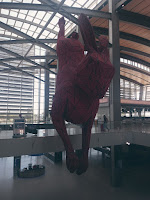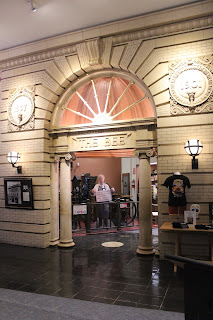 |
| Lassen Peak from Redding |
For many, Northern California stops north of San Francisco, at best where wine country hits its limit.
But the state claims another 300 miles of coastline north and a few hundred miles east to Nevada. This stretch of Northern California stands as a world apart, not just because of the world’s tallest trees on the coast.
The northern Sacramento Valley has a different feel from the rest of the state. Flying in, we coasted past the High Sierras, Yosemite National Park still covered under snow, Mono Lake and more.
 |
| Death Valley under clouds |
 |
| Mono Lake with Yosemite to the west |
 |
| Snow-covered Sierra Nevada |
 |
| Central Valley, nearing Sacramento |
When the farmland rushes in, Sacramento draws close. Sacramento sits on these fertile plains, its eastern flank undeveloped due to a giant floodplain. The farmland runs all the way up to Redding, where the Sacramento River claws down from the mountains.
 |
| Giant suspended rabbit |
This is agriculture country, even at the north end of California’s Central Valley. What seem like shallow ponds along the road are actually rice fields, one of the many local crops. On other drives, we encountered almond, olive, and pistachio orchards in straight rows from the road to the horizon.
In Yuba City, wild chickens roam the roadside. California is still California, even in the parts where people don’t often explore. That’s all I remember of Yuba City but seeing them is as solid a memory as any place needs. I wanted to explore Lassen Peak, but the volcano’s highway was still covered in snow. Next time, I tell myself.
 |
| Orchards |
I can say I saw Lassen Park from many vantage points, just not as close as I would have liked. From California 99 I caught glimpses of the volcano, including some prominent ones up in Red Bluff and Redding. The larger Lake Oroville lies east of Route 99, and it was unmistakable in its size and importance to the region in keeping agriculture thriving. Even then, the areas along 99 were an extended afterbays of the main reservoir.
When we turned to Chico, it felt like a large college town, with much of the housing stock unchanged for 80 years or more.Just as I satisfied a long-running beer itch in Eureka (and had no idea how close I’d come in 2011), Chico had its own signature brewery, one of the vanguards of craft brewing. While there were a half-dozen other breweries in the town of 100,000, we had to go to Sierra Nevada Brewing in Chico.
No excuses would hold. The long-running craft brew innovator had a massive complex with a lovely dinner spot, with two dozen house-made beers on tap and a broad menu with dishes that one could easily make a second meal from the leftovers. They had the Sierra Nevada Porter on tap, a beer I had not seen on shelves in two decades but I always remembered as the first domestic craft porter worth drinking. From the tap, it thrilled me once again.
 |
| Sierra Nevada, well worth the visit. |
Other roaming in Chico was somewhat limited due to time on the Redwood Coast. We had Sunday breakfast on the open roof of Stoble Coffee, which emphasizes its local ingredients and serves a fine breakfast sandwich. It’s as tall as most of the buildings in downtown Chico.
I could have explored more but time runs out quickly on a long weekend, and we had to venture south to Sacramento. We stopped at the state capitol; it had been several years since I added a new one to my list.
The California capitol could have the most densely forested capitol grounds, as the backside of the building opens onto a forested park (that was closed this Sunday). But the boulevard outside the capitol was home to palms, redwoods (much smaller in this climate), pines, and scores of other trees. A rather angry-looking California Highway Patrol officer stood abreast his cruiser. I didn’t even consider approaching the building. Down the hill from the capital complex lies the city’s biggest draw, Old Town Sacramento on the riverfront.
Despites its role as capital, Sacramento qualifies as California’s most anonymous big city. With a half-million people, most people have no image of the city. I can’t say I did.
After Jolene dropped me at my hotel, I had to wander. I was not ready to sit in a hotel room and stew until I had to call a morning Uber for the airport. The bartender told me about the neighborhood. Pre-interstate, travelers from the east enter Sacramento via the neighborhood, and it was a vibrant neighborhood. Bypassed by Interstate 80, it went forgotten and fell into neglect. A man sat in the median advertising his BBQ restaurant. Hopefully he won't have to do that forever.
Sacramento sits where the American River meets the Sacramento River. Like its namesake town, the river is quietly one of the longest and most important nationally.
The geography of Sacramento was a mystery to me. I had no idea that the Sacramento River ran all the way to San Francisco Bay, and its size allowed would-be millionaires to jump on riverboats to feed their hopes of striking it rich after Sutter’s Mill set off the California Gold Rush. The riverfront has a paddleboat hotel and the brick-paved district covers dozens of period buildings that now include bars, restaurants, numerous boutiques, and other shops.
 |
| Old Bee Building entrance |
The Sacramento History Museum sheds a lot of light on how the city sprang up. Housed in a reconstruction of the 1854 City Hall and Waterworks building, which originally include the mayor’s office, the city court, and its jail. The original building fell into disrepair and its replacement fit with the look of Old Sacramento.
The museum includes the reassembled entrance from the original Sacramento Bee building, taken apart when it was demolished in the 1950s and later made its way to the museum, along with a number of historic printing presses. Other exhibits looked at the gold mining and a seasonal exhibit highlighted tattoo artistry on Sacramento women through the decades.
An afternoon tipple seemed appropriate, and we found a nearly empty tasting room. Fenton Henriot operates a tasting room in Old Sacramento at the original street level, which is a good 10 feet below most of Old Sacramento and more below the modern city. They have a vineyard and tasting room in Placerville, in the Sierra Nevada foothills. The affable German tasting room manager walked us through their whole portfolio.
So let people say what they will about Sacramento (they will say it, and with great frequency). It was an affable town. Before I spent any time in the capital, days in Chico and on the Redwood Coast already reset my image of this less-seen chunk of Northern California.











No comments:
Post a Comment